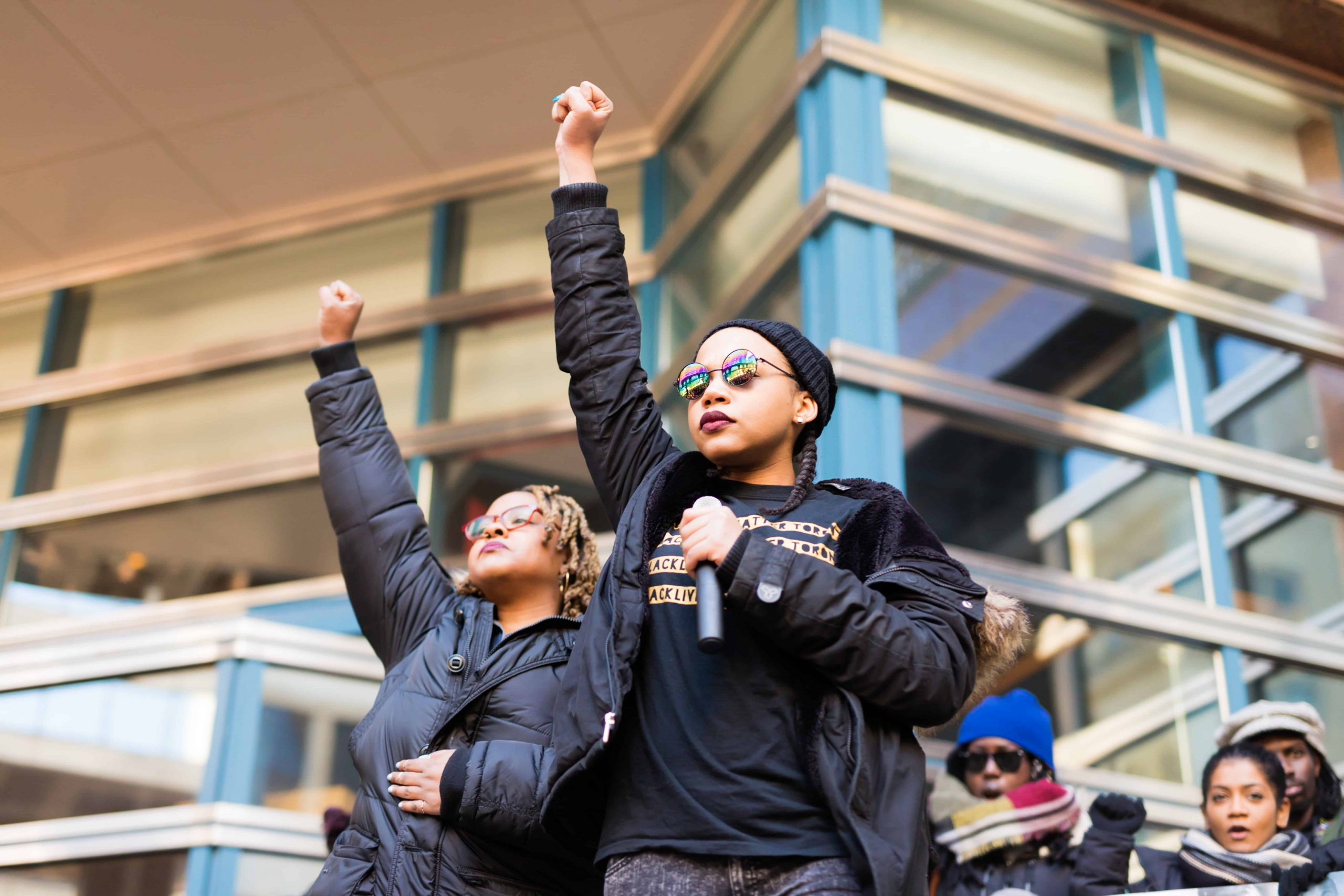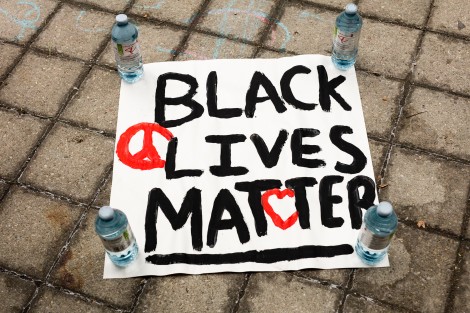[dropcap]D[/dropcap]r. Martin Luther King Jr. once warned of an unsuspecting threat to Black liberation called “the white moderate.” He defined white moderates as people who prefer the “absence of tension” over the “presence of justice” and say, “I agree with you in the goal you seek, but I cannot agree with your methods of direct action.” The white moderate “paternalistically believes that he can set the timeline for another man’s freedom.”
If Black Lives Matter (BLM) is today’s civil rights group, then Canadian media is the white moderate at best and an antagonist at worst. This has become strikingly evident, given the outpouring of disappointing coverage in response to BLM Toronto’s (BLMTO) recent sit-in at Toronto’s Pride Parade — coverage that makes a mockery of the BLM movement, while simultaneously refusing to acknowledge that anti-Black racism continues to exist both in Canada and the United States.
In the Toronto Star, for instance, an editorial claimed that, while BLMTO is usually righteous, their actions at the Toronto Pride Parade went too far and stepped on the toes of allies. The activist group, an ’honoured guest’ at the parade, apparently should have opted for friendliness over confrontation, given the fact that the LGBTQ+ community are considered their allies.
Such a naive comment is symptomatic of the moderate, who supposedly understands and sympathizes with the cause of the marginalized but cannot tolerate the rage and urgency that naturally underlies it. It also ignores the fact that LGBTQ+ people can be racist as well. When reflecting on the public’s response to their sit-in, Rodney Diverlus of BLMTO tweeted that the first group of people to chant “all lives matter” — a phrase that trivializes racism and violence against the Black community by insisting everyone be treated equally despite unequal levels of disadvantage — were white queer people. There is clearly still more work to be done.
As John Ibbitson wrote in the The Globe and Mail, the face of the gay rights movement has always been that of a white, middle-class man. Sexuality aside, an otherwise privileged group like this faces much less resistance in having their rights acknowledged than Black people, much less the many Black women and trans people who populate BLMTO. This reality explains why Pride can be infuriating to people of colour; at the end of the day, it still appears to be a celebration of cisgendered white men, despite the fact that monumental moments in the fight for queer rights, such as the Stonewall riots, were both initiated by people of colour and trans people.
Ibbitson’s more conscientious analysis is in stark contrast to that of his colleague Margaret Wente, The Globe and Mail’s star columnist and plagiarist-in-chief. In typical Wente fashion, her piece was condescending, bereft of depth, and overall dismissive of views that challenge her own. She called BLMTO “bullies” backpacking on the racial tensions of America, as if Canadians were innocent of racial resentment. For Wente, BLMTO simply ought to have been happy they were present at Pride; she believed the group’s protest was little more than whining. She crudely labelled most of BLMTO’s demands as asking for money for their personal projects, ignoring the fact that they have consistently urged Pride to strive for greater visibility, the inclusion of South Asian and Indigenous peoples, and increased accessibility for people with disabilities.
Wente took particular offense to BLMTO’s demand for the elimination of police floats in future parades. Her view that police floats symbolize “solidarity and inclusion” ignores the fact that both Black and queer people, and especially trans people, are justifiably fearful of police, who have a history of subjecting these groups and other marginalized groups to scrutiny, harassment, and violence. With this context in mind, seeing the police occupy space on a float in a parade dedicated to the inclusion of LGBTQ+ people is a taunt — and a violent one at that — for many queer people of colour.
Perhaps the most insulting part of Wente’s column is that she claimed Toronto is so much better for Black and queer people than other places in the world, consequently insinuating that Black and queer people should be grateful to only have to experience the lesser of two evils.
Similar sentiments were penned in the National Post, when Robyn Urback — despite acknowledging race as a factor in the pushback against BLMTO — wrote that Pride was an example of the political left “eating itself,” because two groups concerned with progress clashed. Holding groups that claim to be progressive to account can only be a positive thing, and BLMTO was right to expect more of Pride.
One can argue that today’s Pride, embellished with corporate sponsors, pinkwashing, and shallow support, is now more a celebration of past achievements than an event seriously concerned with marching further towards equity. Certainly, considering the backlash to BLMTO, the parade is a far cry from its political roots, meant to commemorate the Stonewall riots, which were initiated in protest against police brutality and led by queer and trans people of colour.
The media’s less-than-savoury takes on BLMTO are particularly appalling considering the position from which BLMTO is speaking. Amid the frequent shooting of unarmed Black people in both the US and Canada, BLMTO’s demand to ban police floats from the parade is not surprising. It is unnerving, to say the least, to march alongside an institution that can destroy you with impunity. One need only to look at the dozens of instances of police brutality against Black people in the United States — Tamir Rice, Michael Brown, Alton Sterling, and Philando Castile are just four of the Black lives that have been taken by police. Closer to home, the violence persists: consider the shooting of Andrew Loku by Toronto police, and the recent death of Abdirahman Abdi, a mentally ill man that was beaten to death by the Ottawa Police.
It is not that BLMTO’s demands or their strategies cannot be criticized. Yet, such criticism must be directed in a constructive manner, in a manner that, at the very least, acknowledges anti-Black racism and does not obscure the truth.
[pullquote-default]All marginalized groups find themselves underrepresented in journalism, and that’s a moral and a business problem.[/pullquote-default]
Fortunately, not all media perspectives on BLMTO have been so narrow-minded. While it isn’t necessary to share the identity of those one writes about, Desmond Cole, a Black writer, provided much needed context and clarity in his Toronto Star column amid a series of tone-deaf hot takes elsewhere in Canadian media. He notes how the media-manufactured Black vs. queer dichotomy erases the intersectional issues that queer Black people face — issues that arise as by-products of two overlapping marginalized identities, each with their unique lived experiences of oppression. Furthermore, Cole discusses how queer people of colour are alienated at Pride and in LGBTQ communities as a whole. Though it was not his responsibility to do so, Cole did well in explaining why BLMTO’s actions were justified, and this was a welcome contrast to many of the more dubious perspectives provided by his colleagues.
The reaction to BLMTO’s actions at Pride are symbolic of a bigger issue in Canadian media: an alarming lack of diversity. All marginalized groups find themselves underrepresented in journalism, and that’s a moral and a business problem. Identity cannot replace journalistic ability, but it can add valuable nuance and context when covering queer and racialized communities. Journalism where people are able to tell their own stories — if they choose, not because they are tokenized and pigeonholed to do so — can only be seen as a positive.
This is not to mention the fact that the media, by means of reaching a large audience, can set the stage and the standard for what kind of content constitutes legitimate, appropriate journalism. When BLM is caricaturized, but their notable achievements are not given air time, the seedy priorities of the media shine through — they paint racial justice activists as people not worth listening to, while obscuring discussions of their actual work.
Even beyond this, there are undoubtedly more overt and crass instances of racist content being published by the media. The Varsity is far from innocent of this — in 2007, for example, a blackface cartoon was published in our paper, something that we have yet to formally issue an apology for; we aim to officially amend this disgrace in the coming weeks.
Canadian media should commit to increasing diversity in newsrooms, which would increasesthe quality of journalism. Without Desmond Cole, there would only be one Black columnist in the mainstream media: Royson James of the Toronto Star. The Varsity now has a diverse masthead, but we do not entertain the notion that the mere presence of diversity will be enough to combat racism, both in terms of our workplace environment and the content that we publish going forward.
In order to work to combat racism in the media, a conversation needs to be had about the way race and racial issues are portrayed to the public, as well as the responsibility that media outlets have to tell a conscious story, not just one that makes headlines.



